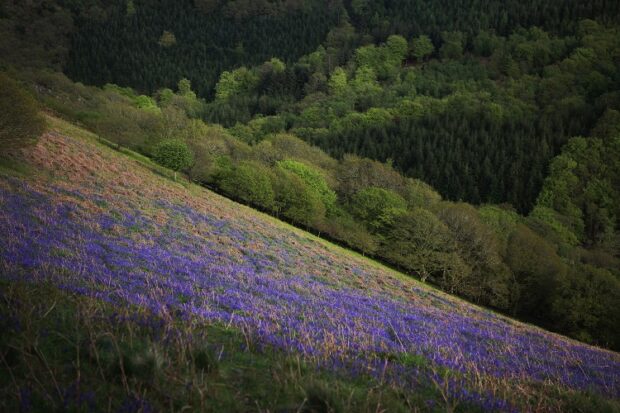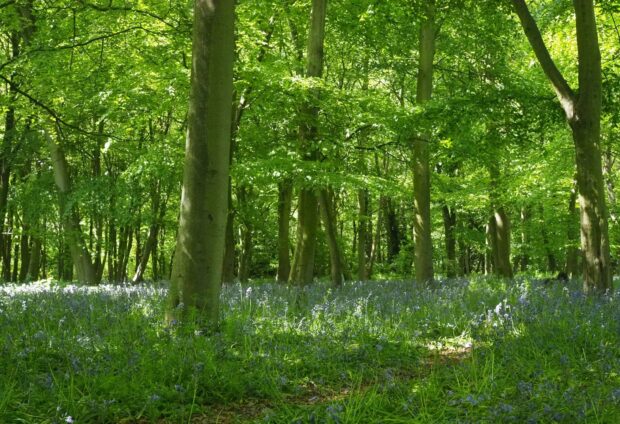
A joint blog post from Defra, Forestry Commission, Natural England and the Woodland Trust.
The revised Keepers of Time Policy for ancient and native woodland and ancient and veteran trees has been launched.
England’s ancient woodlands and ancient and veteran trees are a special part of our history and legacy, they are the jewels in the crown of England’s treescape.
England is home to some of the best examples of ancient woodlands, ancient wood pastures and parkland and ancient and veteran trees. These irreplaceable habitats must be protected. Their long-standing presence, species and form serve as a rich cultural record of past management practices. They support high levels of biodiversity and are home to a quarter of England’s priority species.
These trees and habitats are important in so many ways and we must protect and improve them for people, nature, climate and the economy. They deliver many ecosystem services from tourism to cleaning our air while also providing timber and non-timber products.
What is Keepers of Time and why has the Government committed to updating it?
In the England Trees Action Plan the Government committed to review and update Keepers of Time, using the latest evidence and information available and focussing on the most important issues faced today.
The Keepers of Time policy outlines the value of England’s ancient and native woodlands and ancient and veteran trees. It states Government’s commitment to evaluate the threats facing these habitats and sets out England’s updated principles and objectives to protect and improve these habitats for future generations.
This policy provides an overarching statement for decision makers to protect and improve ancient and native woodland and ancient and veteran trees which will be delivered through other current and future policy.

What’s new?
Defra have refreshed the whole policy to reflect the importance of ancient and native woodlands and ancient and veteran trees, some of the key updates include:
- introducing a hierarchy of value to illustrate the different values associated with ancient and native woodland and ancient and veteran trees
- refreshing the policy principles and strategic objectives including greater reference to resilience from climate change, pests and disease to ensure these habitats are protected from these threats in future
- including greater reference to ancient and veteran trees and ancient wood pasture and parkland. This highlights their importance as irreplaceable habitat alongside ancient semi-natural woodland and plantations on ancient woodland sites
- introducing a new category of Long Established Woodland - woodland that has been present since 1893 - recognising their important ecological and societal value. We will consult on the protections these woodlands are afforded in the planning system.
There is also a series of actions that government is taking to better protect and improve our ancient and native woodlands and trees over the coming years.
Working together to protect and improve these valuable habitats
Keepers of Time has always been a policy statement which holds great value to key partners, stakeholders and policy makers alike. It was important that as part of this revision, Defra and Forestry Commission continued to work closely with these groups to make sure that value was retained. While the Forestry Commission led the review, they worked hand in hand with colleagues in Defra and Natural England, across other government departments and engaged closely with others including the Woodland Trust.
A spokesperson for Natural England said
Natural England owns and manages the Ancient Woodland Inventory, which is a keystone of evidence for identifying ancient woodland. Had our predecessors realised what it was they had created, I hope they would be very pleased. The evocative name of the policy statement has been retained, by popular request, and it speaks volumes about what it seeks to protect. The need for this policy document is still as valid today as it was when first published in 2005, and the publishing of this refreshed statement, reflecting the latest evidence, is testament to this.
It very much underpins our work in offering protection for irreplaceable habitats. It underlines the importance of native woodland in government thinking, as we also endeavour to achieve the ambitious targets set out in the England Trees Action Plan. Natural England believes that the recognition of wood pasture and parkland as a form of ancient woodland is another big step forward in our thinking on ancient woodland.
A spokesperson for the Woodland Trust said
When we think of trees playing a part in tackling the climate and nature crisis, we often think of tree planting. While we urgently need to expand tree cover through natural regeneration and planting the right tree in the right places, this has arguably cast our existing woods and trees in the shade and left a story untold. Only 7% of the UK’s native woods are in a good ecological condition and the wildlife it is home to is in rapid decline.
Keepers of Time is a significant step in acknowledging the role of ancient trees and woodlands, which are some of our most precious and biodiverse habitats. Our ancient woods now cover less than 3% of the UK and half of them need urgent restoration.
If the ambition of this policy is delivered, including the commitment to restore our ancient woodland and protect ancient trees, it has real potential to help support nature recovery across England.
By combining the expertise of government bodies such as Forestry Commission, Natural England and civil society organisations, including the Woodland Trust, Defra have published a much-needed policy that deserves backing with the partnerships, resources and action to ensure its full implementation.

The Queen’s Green Canopy
Our commitment to protect and improve these important trees and woodlands was showcased recently as part of The Queen’s Green Canopy (QGC). His Royal Highness The Prince of Wales unveiled a nationwide network of 70 Ancient Woodlands and 70 Ancient Trees to be dedicated to Her Majesty in celebration of the Platinum Jubilee.
By sharing the stories behind the ancient woodlands and trees, as well as the incredible efforts that are made to protect them, The Queen’s Green Canopy aims to raise awareness of these treasured habitats and the importance of conserving them for future generations.
Included in the 70 ancient woodland and trees dedicated to Her Majesty are the following sites:
- Bolderwood in the New Forest, Wyre Forest in Worcestershire and Lady Park Wood in Gloucestershire (Forestry England)
- Yarner Wood and Bovey Valley National Nature Reserve in Dartmoor, Langley Wood National Nature Reserve in Salisbury, Gait Barrows National Nature Reserve in Lancashire (Natural England)
- Fingle Wood, Devon (Woodland Trust)
- 350-year-old sweet chestnut tree located at Temple Newsam Estate (Leeds City Council, close working partner of White Rose Forest, Community Forest)
- Tehidy Twisted Beech – Forest for Cornwall
You can read and download a copy of Keepers of Time: ancient and native woodland and trees policy in England at www.gov.uk/government/publications/keepers-of-time-ancient-and-native-woodland-and-trees-policy-in-england.



3 comments
Comment by rob yorke posted on
Just wondering why no quote from a Forestry Commission spokesperson or perhaps the Chair, CEO?!
Lovely and important as this is, I do hope the presence of ancient trees does not become an overly precautionary obstacle to innovative mixed planting, incl allowing natural regeneration, of different tree species nearby.
Rob Yorke
robyorke.co.uk
Comment by rob yorke posted on
Just wondering why no quote from a Forestry Commission spokesperson or perhaps the Chair, CEO?!
Lovely and important as this is, I do hope the presence of ancient trees does not become an overly precautionary obstacle to innovative mixed planting, incl allowing natural regeneration, of different tree species nearby.
Rob Yorke
robyorke.co.uk
ps if this posts a number of times, it’s because, from experience, the unnamed writer of this blog does not moderate and post comments!
Comment by Luke Hemmings posted on
Would have been nice to see a comment from the FC, seeing as they are supposedly the Govt's trees and woodland experts...